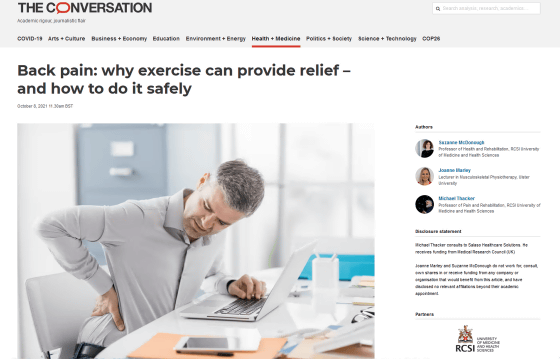Why is 'exercise' effective in relieving back pain?

Many people may think that if you have 'back pain', you should definitely rest and rest your back, but exercising
Back pain: why exercise can provide relief – and how to do it safely
https://theconversation.com/back-pain-why-exercise-can-provide-relief-and-how-to-do-it-safely-162888

When it comes to back pain, it is easy to think that it is better to stay still and rest, but in reality, it is easier to relieve the pain by doing some kind of exercise, and it is less likely that you will have back pain after that. “Regular movements and exercises help improve and recover strength, endurance, and flexibility, and help you recover from an acute low back pain attack faster from your lower back. Staying active is one of the most widely and consistently recommended reasons for managing back pain, 'says McDonough and colleagues.
Although it is known that exercise is effective for back pain, it seems that research is still ongoing on why exercise is useful for reducing back pain and the optimal amount of exercise for reducing back pain. The traditional view of why exercise relieves back pain is 'because exercise strengthens the muscles around the spine and the abdomen.' This idea seems to be partially supported by research results, but it does not fully explain why exercise relieves back pain.
According to McDonough et al., In recent years, research results (PDF file) that 'exercise brings about beneficial changes in the function of the nervous system including the brain' are increasing. The phenomenon in which exercise reduces sensitivity to potentially harmful stimuli and relieves pain is referred to as 'exercise-induced hypoalgesia.' For example, a study of chronic painless adults reported that people who underwent high-intensity aerobic exercise, such as 15 minutes of cycling or running, had reduced pain sensitivity over the next 30 minutes. ..
Exercise-induced analgesia is supported by several mechanisms, such as the benefits of exercise, such as 'stimulating the secretion of substances such as endocannabinoids , adrenaline , noradrenaline , endorphins, and serotonin , reducing pain and improving mood.' Is one of them. In addition, it is thought that the fact that exercise causes changes in the connection and structure of the nervous system (neuroplasticity) also leads to relief of pain over time. Research into exercise-induced analgesia is underway, but most (PDF file) studies report that some exercise can relieve pain, even when it is in pain.

Regarding exercise to reduce back pain, it does not mean that specific exercise has the effect of improving back pain, and any exercise will help reduce back pain. However, this does not mean that 'even if you force yourself to run or lift a heavy barbell, your back pain will be alleviated', and in order to avoid injury, exercise within a reasonable range and gradually increase your intensity. Is important.
'The most important thing is to do what you enjoy and continue, which will reduce your pain and hopefully prevent it from recurring,' McDonough and colleagues said. 'Every few hours. There are also many easy ways to get more exercise on a daily basis, such as going up and down stairs several floors and doing short exercises multiple times during the day. Or consider a standing desk. '

Related Posts:
in Science, Posted by log1h_ik







